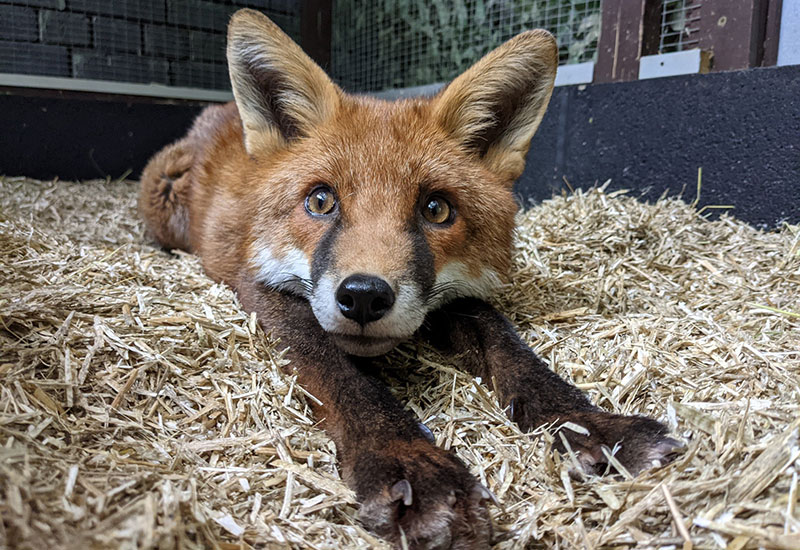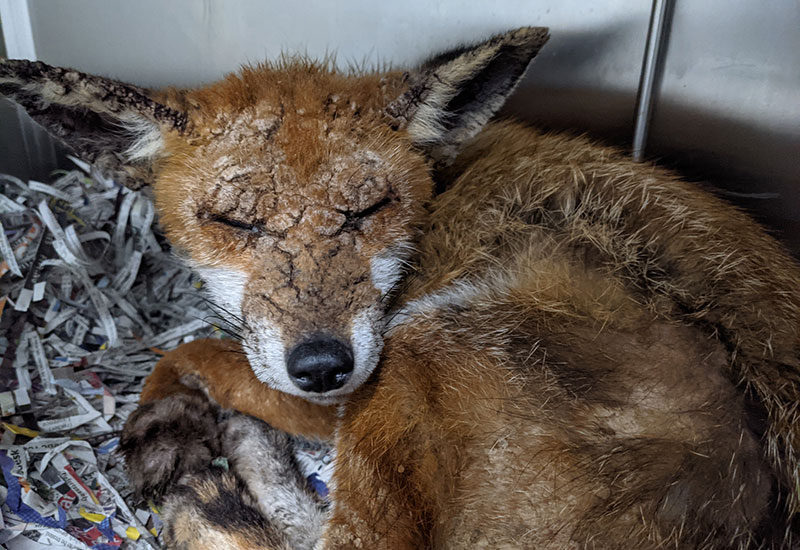
Foxes are members of the dog family (canidae) and are the largest sub family of this group with 21 species of fox across the globe but the only one native to this country is the red fox.
Family Groups
Foxes live in family groups, but hunt and forage alone. Groups are comprised of a male (dog) fox, a dominant female (vixen) and several non-breeding vixens known as subordinates who share the territory and help rear the dominant vixen’s cubs. If anything happens to the dominant vixen,
subordinates will also act as surrogates and foster her cubs.
Normally there are no more than 2 subordinate vixens but family members up to 8 adult foxes have been reported and this may include more than one adult male.
Calendar of Events
Around the beginning of spring between March and April sees the birth of cubs, who are dependent on parents between birth up until around July, when they start to fend for themselves and adults bring them less food.
Cubs will be indistinguishable from parents come September and begin to disperse and find their own territories from October and this can go on till February in some cases. Territory boundaries and defence of territories is relaxed during this period. Mating occurs in December and January and the vixen is only on heat for 3 days during this period.
Territories
Foxes are territorial animals, and thus there will only be a certain number of foxes in an occupied area, in the form of a family group as described above. The size of these territories is dependent on food availability, with a higher amount of food being available resulting in the foxes not having to travel as far to find sustenance, and thus territories in such areas are smaller. Territories tend to be larger where food is scarcer, and the foxes have to cover a larger area to source enough food. Generally speaking, territories in urban areas are smaller than rural areas, where food is more
plentiful.
It is the territorial nature of foxes that means we always release foxes we’ve had in our care back to the area they were picked up from. To relocate elsewhere would result in danger of putting them into the territory of another fox. The territorial behaviour of foxes is also how they control their own numbers, and why arguments for killing are without merit. Quite simply, removal or dispatching a fox will result in a fox from the surrounding territory to take over its place, thus making it a pointless exercise, and can in fact make matters worse, with foxes from the surrounding areas competing for the newly available territory.
Foxes are resourceful animals, and have several homes (dens) in their territory, so that in the event one is compromised, they have a backup option. These dens can be in the form of spaces underneath decking/sheds in gardens, underneath rockeries or in the side of embankments, to old badger setts with numerous entrances/exits and tunnels.
Diet
Foxes are classed as omnivores, eating a combination of insects, small animals, fruits and essentially whatever they can find in rubbish left by humans/leftovers that people feed them. In general, anything goes with regards to a foxes diet and they are opportunistic and will eat what’s available. The most common food source in rural areas is wild mammals such as rabbits and voles, whereas in urban areas it’s mainly scavenging that forms majority of the fox’s diet.
Foxes have a natural instinct to take food away and bury it (cacheing), which can be eaten on the same day or at some point in the future, depending on how much food is available. The larger the food item, the more likely the fox is to carry it away. This cacheing behaviour is a survival instinct that we even see in foxes in the unit, as they will commonly bury food in the kennels under shreddy/bury food in pens under shavings. The purpose is to safeguard food for future when there may be shortages. It is also the reason why foxes who get into a hen house will tend to kill all chickens they can, to secure a food supply for the future.

Mange is caused by a mite which burrows under the skin of the fox. Unlike fleas the mites don’t jump therefore the condition is passed by close contact between animals. The mites cause intense itching resulting in fur loss and cracked skin, which may become infected. As the condition progresses, secretions cause ‘crust’ to form on the skin, the fox becomes dehydrated and may also develop conjunctivitis. Left untreated the condition will ultimately be fatal.
We get many calls and messages every day from all over the UK (and overseas), about foxes with mange and as trapping is so stressful if we can help to resolve problems without trapping it’s by far the best option. For ‘mild mange’ we opt to try the homeopathic route first. We would class mild mange as a fox which has no more than about 30% fur loss over the whole fox ie lost fur on the tail and back end, or in patches. There will be no crusty skin and eyes will be fully open with no associated conjunctivitis.
Many people are divided on the homeopathic remedy and whether it does actually work. We are not vets, doctors or homeopathic practitioners, and we’re not suggesting that the homeopathic remedy will kill mites in the same way as conventional treatment does, all we can say is we send out a huge amount of the remedy and we get a huge amount of positive feedback from people telling us their foxes have recovered. We send the remedy out along with advice on good nutrition and also a follow-up service where necessary. It may be that the remedy, along with a regular source of good nutrition, is enough to boost the fox’s own immune system to enable it to overcome the mange. Poor nutrition and/or chronic stress can supress the immune system. A big advantage of the remedy is that it’s safe for all animals and you can’t overdose, so as long as the fox has recovered and we’ve done no harm, that’s all that really matters.
If the mange has gone beyond the homeopathic stage and the fox is within reach of us (ie North West / West Mids.) we’ll opt to trap/treat/release by giving a conventional spot-on treatment and immediately releasing the fox. For cases beyond our reach we’ll try to find a rescue more local to the fox. Only when the fox has severe mange do we trap and admit the fox into the rescue for treatment. Once treated the fox will be returned to the exact location it was trapped.
Foxes are omnivores, eating a combination of insects, small mammals, birds, fruits and whatever they can scavenge. They are opportunistic and adaptable and will eat whatever is available.
If you choose to feed your local foxes, good nutritious food could include tinned dog food, cooked meats (no cooked bones), raw meat on the bone such as raw chicken thighs etc., plain peanuts, bits of fruit ie pieces of apples/pears, eggs (raw in or out of the shell, or cooked). Leaving fresh water out is a good idea too. However, we recommend that you only support feed, giving small amounts of good nutritious food, rather than giving large amounts of food. We would also recommend that you scatter the food around (instead of putting it all in one pile), vary the times you feed, and miss a day or two each week. It’s best not to leave food close to your house, try not to let them see you putting food out, and please don't encourage the fox to trust you, or feed it by hand. Encouraging this behaviour can put the fox at risk and bring it into danger from people who do not like foxes.
Overfeeding can result in changing natural behaviour and reducing territory size, as this is linked to the supply of food, and this will have a detrimental effect on the foxes. Overfeeding can also result in foxes becoming reliant on you so if for any reason you have to stop, the foxes will then struggle. It may also cause them to cache (hide) large amounts of food in other people's gardens. This can cause issues for both you and the fox, as your neighbours are unlikely to want holes dug in their gardens by the local foxes burying their surplus food, and they then may take things into their own hands to 'get rid' of the fox. A reduction in territory size will also result in bringing neighbouring foxes into more frequent contact with each other, possibly causing territorial battles, and may also increase the chance of passing on diseases, including mange.